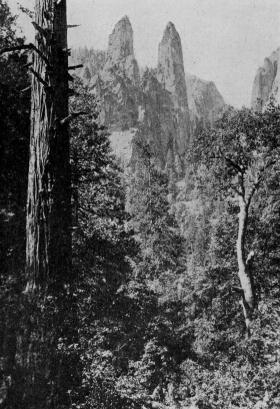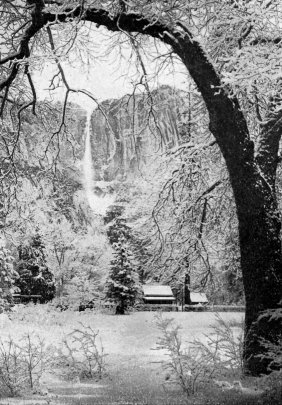
THE CATHEDRAL SPIRES
2,678 feet
| Online Library: | Title | Author | California | Geology | History | Indians | Muir | Mountaineering | Nature | Management |
Yosemite > Library > Yosemite Valley > Plants >
Next: Ferns • Contents • Previous: Shrubs
THERE are said to be over one hundred different kinds of flowering plants in Yosemite. Only a very few of them will be here mentioned, and, as the author is not a botanist, no attempt will be made to give a minute botanical analysis.
Persons visiting Yosemite who wish to study the flowers there, should provide themselves with Mary Elizabeth Parsons’ illustrated book on "Wild Flowers of California." It is one of the best books of the kind published for beginners in the study of flowers.
Black-eyed Susan (Hellenium grandifolia)—This, with its numerous showy yellow flowers, is very abundant along the lowlands of the streams and marshy meadows.

THE CATHEDRAL SPIRES 2,678 feet |
Shooting Stars or Wild Cyclamen (Dodecatheon Meadia)—This is a very early spring flower growing in wet ground. Its stems are a foot or more high. These flowers are peculiar in appearance, are of varying color, and very beautiful.
Small Tiger Lily or Alpine Lily (Lilium parvum)—This lily grows in rich, moist soil and wet meadows. Its rich green leaves are in a succession of whorls up the stem, which is sometimes six feet high and crowned with a head of numerous small orange-colored flowers. It blooms during the months of July and August.
Rein Orchis (Hebenaria leucostachys)—This is found in the wet meadows, two to three feet high. Its flowers are pure white, in a long dense spike. It blooms late in the summer.
Yellow Pond Lily (Nuphar Advena)—The only place in Yosemite where this lily is found is in a little pond a short distance from the Sentinel Hotel, on the opposite side of the river. In the higher range of mountains it is found in many small shallow ponds.
The Evening Primrose (Enothera biennis)—This is very common in Yosemite, growing from two to three feet high, terminating in a long slender head with a series of upright buds in various stages. of development. It begins blooming at its base about sunset, one or more buds, bursting from their close wraps and developing within about five minutes into large yellow flowers, which wither next day and are followed by new ones every evening.
Pussy’s Paws (Spraguea umbellata)—This grows in sandy soil. It flowers in dense spikes of a rose color, growing in a bunch much resembling a kitten’s foot, hence the name "pussy’s paws."
Lupines (Lupinus bicolor)—Lupines are very abundant in Yosemite, growing in sandy soil. Nearly all of them have bi-colored flowers—blue and white.
Indian Paint Brush (Castilleia latifolia)—This plant, with its elongated bright scarlet head, is very conspicuous among its vivid green surroundings. It blooms in June.
Collinsia (Collinsia tinctoria)—The Collinsia, with its delicate showy white-and-purple blossoms arranged in many storied rings, grows in the dense shade of the great black oaks in Yosemite. When picking the flowers the sap of the stem stains the fingers a brown color.
Godetia (Godetia amoena)—In early summer this plant, with its delicate dark pink flowers blotched with bright crimson, is one of the most beautiful and showy flowers in Yosemite. The flowers close up at night and open the next day. It is sometimes known "Farewell to Spring. "
Yarrow (Achillea millefolium)—The yarrow is very common in Yosemite, but its white flowers, in a dense flat cluster, are seldom honored by a place in a choice bouquet. It was formerly in high repute for its varied medicinal qualities.
Great Willow Herb (Epilobium spicatum)—This grows very luxuriantly in some parts of the Valley, being from four to seven feet high, terminating in a great spike of very showy pink flowers which commence blooming late in July. Its roots are said to contain valuable medicinal qualities of a tonic character.
Coreopsis—A variety of wild coreopsis is seen in all parts of Yosemite Valley, from one to three feet high. It has, bright yellow flowers, which partly close at night, opening out early the next morning, and seem to turn their bright faces towards the sun throughout the day, apparently being devout sun worshipers.
Snow Plant (Sarcodes sanguinea)—This blood-red and brilliantly attractive plant is met with in a few localities in Yosemite. The stout succulent stem, covered with waxlike, bell-shaped flowers, and delicate, semi-transparent, slender leaves that intertwine among the bells, all being blood red, makes it the most conspicuous and beautiful flower in the Sierras. It is met with on all the routes to Yosemite and the Big Trees. The name it bears might give the impression that it grew in the Sierra snows, but this is not the case. It never shows its red crown until several days after the winter snow has melted away. Sometimes, however, a snow storm may come in the spring after it is up in full bloom. It is thought by some botanists to be a parasitic plant, they claiming that it only grows on the decaying roots of some coniferous trees. This has been well proved to be untrue.
Other Flowering Plants—Golden Rod (Solidago Californica), Blue Larkspur (Delphinium), Columbine (Aquilegia truncata), Golden Star (Bloomeria aurea), Blue Milla (Brodiaea laxa), blue and other varieties of the Penstemon, blue, yellow and white violets, and many other very beautiful flowering plants, are well represented in Yosemite. The open expanse of green grassy meadows, bespangled with a multitude of bright colored flowers, is a most charming feature of the landscape.

YOSEMITE VALLEY IN WINTER [Photo by George Fiske] |
Next: Ferns • Contents • Previous: Shrubs
| Online Library: | Title | Author | California | Geology | History | Indians | Muir | Mountaineering | Nature | Management |
http://www.yosemite.ca.us/library/the_yosemite_valley/plants.html